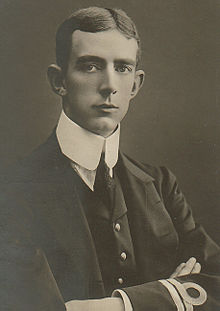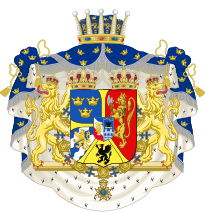Prince Wilhelm, Duke of Södermanland
| Prince Wilhelm | |||||
|---|---|---|---|---|---|
| Duke of Södermanland | |||||
 Prince Wilhelm of Sweden and Norway | |||||
| Born | 17 June 1884 Tullgarn Palace, Trosa, Sweden | ||||
| Died | 5 June 1965 (aged 80) Stenhammar Palace, Sweden | ||||
| Spouse | Grand Duchess Maria Pavlovna of Russia | ||||
| Issue | Prince Lennart, Duke of Småland | ||||
| |||||
| House | Bernadotte | ||||
| Father | Gustav V | ||||
| Mother | Victoria of Baden | ||||
Prince Wilhelm of Sweden and Norway, Duke of Södermanland (Carl Wilhelm Ludvig; 17 June 1884 – 5 June 1965) was a Swedish prince. He authored a large number of books (primarily in Swedish) as Prins Wilhelm.
Personal life
Wilhelm was born at Tullgarn Palace, the second son of King Gustav V of Sweden and his Queen consort Victoria of Baden.
Marriage and divorce
On 3 May 1908, in Tsarskoye Selo, Wilhelm married Grand Duchess Maria Pavlovna of Russia, a daughter of Grand Duke Paul Alexandrovich of Russia by his first wife Princess Alexandra of Greece. The bride was a cousin of the reigning Russian tsar, Nicholas II and of Prince Philip, Duke of Edinburgh. The couple had only one son: Prince Lennart, Duke of Småland and later Count of Wisborg (1909–2004).
The marriage was unhappy. Their son, Lennart, later wrote an autobiography in which he revealed several details of the Swedish royal family. The autobiography tells of how Maria, like her aunt and namesake the duchess of Saxe-Coburg and Gotha, felt that she had married beneath herself in marrying a younger son of the king of Sweden, and this caused problems of ego between the couple. Maria insisted that the servants address her by her correct style Your Imperial and Royal Highness, to the chagrin of her husband, who was merely a Royal Highness. When apprised of the matter, Wilhelm's father King Gustav V had no choice but to acquiesce with his daughter-in-law's wish, which was perfectly valid in law, and order that the imperial style be used invariably for Maria. Nor was this all. Maria also made her husband feel sexually inadequate.[citation needed] In later years, she would tell people that her husband was a homosexual, or at least sexually inadequate. The suggestion of homosexuality was probably a malicious falsehood because Wilhelm later had a lifelong relationship with another woman.
Maria sought a divorce because of what she described as the horror she then felt toward the Swedish royal family, due to their unlimited support of Doctor Axel Munthe who had accosted her sexually.[1] The divorce was granted in 1914, and Maria returned to Russia.
Later life
Wilhelm had a relationship, which was not publicly known, with Jeanne de Tramcourt which lasted from around 1914 (starting date unknown) until Jeanne's death in 1952. They lived together for more than 30 years on the estate Stenhammar near Flen. This was at a time when cohabitation was very unusual and not officially allowed to occur among royalty. Jeanne de Tramcourt was therefore called his "hostess" at Stenhammar. On 2 January 1952 she died in a car accident in a snowstorm near Stjärnhov in Södermanland, when they were on their way to Stenhammar after visiting Wilhelm's son Lennart. Wilhelm was driving when the accident took place. After this tragedy, he is said never to have recovered.
Career and interests
Wilhelm was a noted photographer and the author of several books written in Swedish under the nom de plume Prins Wilhelm.[2][3]
In keeping with protocol demanded of royalty in modern democracies, Wilhelm kept studiously away from politics. One of his rare forays into the political sphere happened during the Second World War, following the murder of the Danish playwright and Lutheran pastor Kaj Munk on 4 January 1944. It was alleged, perhaps correctly, that the occupying German forces (specifically the Gestapo) were behind the murder, and the Danish resistance newspaper De frie Danske carried condemnatory reactions from numerous influential Scandinavians. Wilhelm was one of those who condemned the murder.[4]
Death

Wilhelm died in is sleep, from a heart attack, in Flen, just 12 days before his 81st birthday.
Honours and awards
Domestic
 Knight, Order of the Seraphim
Knight, Order of the Seraphim Grand Cross, Order of the Sword
Grand Cross, Order of the Sword Knight, Order of Charles XIII
Knight, Order of Charles XIII- In 1904 Prince Wilhelm was appointed a Knight of the Norwegian Lion by King Oscar II. The order was never abolished, but discontinued after Norway became independent in 1905.
Foreign
 Grand Cross, Order of the Netherlands Lion - July 1901 - during a visit to the Netherlands[5]
Grand Cross, Order of the Netherlands Lion - July 1901 - during a visit to the Netherlands[5] Knight Grand Cross, Royal Victorian Order (GCVO) - June 1905 - on the occasion of his visit to the UK for the wedding of his brother Prince Gustaf Adolf of Sweden to Princess Margaret of Connaught
Knight Grand Cross, Royal Victorian Order (GCVO) - June 1905 - on the occasion of his visit to the UK for the wedding of his brother Prince Gustaf Adolf of Sweden to Princess Margaret of Connaught Grand Cross with Collar, Order of St Olav
Grand Cross with Collar, Order of St Olav Knight, Order of the Elephant
Knight, Order of the Elephant
Arms
 Wilhelm's coat of arms as prince of Sweden and Norway, Duke of Södermanland 1884 to 1905 Wilhelm's coat of arms as prince of Sweden and Norway, Duke of Södermanland 1884 to 1905 |
 Wilhelm's coat of arms as prince of Sweden, Duke of Södermanland after 1907 Wilhelm's coat of arms as prince of Sweden, Duke of Södermanland after 1907 |
Ancestry
References
- ^ Lennart Bernadotte in Käre prins, godnatt! ISBN 91-0-041935-4 pp. 155-158
- ^ Amerika från estraden 1928
- ^ Känner du landet 1950
- ^ "KAJ MUNK IN MEMORIAM". De frie Danske (in Danish). January 1944. p. 6. Retrieved 18 November 2014.
Nu er han borte. Myrdet af fire gangstere, en Forbrydelse uden lige. Hvor meningsløst: Ordet dør ikke, fordi man dræber Ordets Forkynder, Aanden knuses ikke af en Revolverkugle. Terror kan aldrig udslette Digterværk, saalidt som den formaar at undertrykke Ideer. Tankens Frihed overvinder selv den væreste Forbrydelse. Kaj Munk blev en Martyr for sit Frihedskrav, men hans skabende Kulturindsats skal leve med stigende Intensitet efter dette. Nordisk Litteratur har Landesorg
- ^ "Court Circular". The Times. No. 36500. London. 6 July 1901. p. 12. template uses deprecated parameter(s) (help)
External links
- 1884 births
- 1965 deaths
- House of Bernadotte
- Swedish princes
- Knights of the Order of the Norwegian Lion
- Recipients of the Order of the Black Eagle
- Recipients of the King Haakon VII Freedom Cross
- Honorary Knights Grand Cross of the Royal Victorian Order
- Knights Grand Cross of the Order of the Falcon
- Dukes of Södermanland
